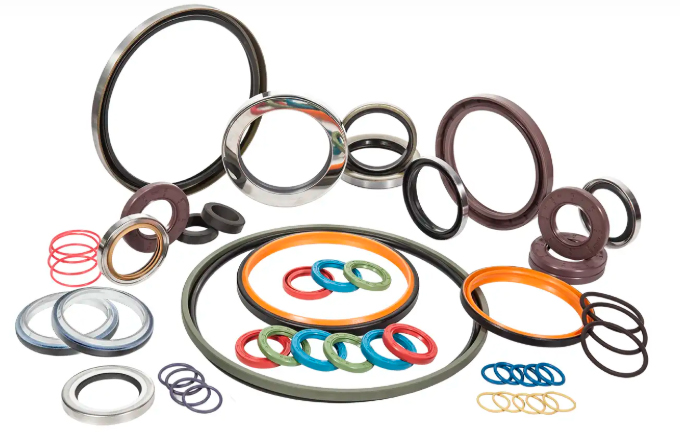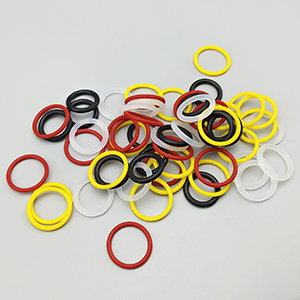In the world of seals and gaskets, O-rings play a crucial role in ensuring the integrity and functionality of various mechanical systems. Among the different types of O-rings available, fluorosilicone and silicone O-rings are popular choices due to their unique properties and versatility. This article delves into the differences between fluorosilicone O-rings (FVMQ) and silicone O-rings(VMQ), focusing on their material characteristics, applications, and performance.

Fluorosilicone rubber, often abbreviated as FVMQ, is a type of silicone rubber modified with fluorinated groups. This modification imparts fluorosilicone rubber with distinct properties that make it an ideal choice for certain applications. Fluorosilicone O-rings, made from this material, are well-known for their excellent resistance to fuels, oils, and solvents, as well as their superior performance in extreme temperatures.
Chemical Resistance: One of the standout features of fluorosilicone O-rings is their exceptional resistance to a wide range of chemicals, including hydrocarbons, fuels, and oils. This property makes them suitable for use in automotive and aerospace applications where contact with such substances is common.
Temperature Stability: Fluorosilicone rubber exhibits impressive thermal stability, maintaining its physical properties over a broad temperature range. These O-rings can typically withstand temperatures from -100°F to 350°F (-73°C to 177°C), making them ideal for both high-temperature and low-temperature environments.
Flexibility and Compression Set: While fluorosilicone O-rings are highly resistant to compression set, they maintain flexibility and elasticity, ensuring a reliable seal even after prolonged use.
Due to their unique properties, fluorosilicone O-rings find applications in various industries:
Aerospace: Used in fuel systems, hydraulic systems, and other critical components where chemical resistance is essential.
Automotive: Ideal for fuel injection systems, turbochargers, and other engine components.
Industrial: Suitable for use in chemical processing and handling equipment.
Silicone rubber is a versatile elastomer known for its excellent thermal stability, electrical insulation properties, and biocompatibility. Silicone O-rings are commonly used in a wide range of applications due to their affordability and general-purpose performance.

Thermal Stability: Silicone O-rings can withstand a wide temperature range, typically from -75°F to 450°F (-59°C to 232°C). This makes them suitable for applications involving extreme temperatures.
Electrical Insulation: Silicone rubber is an excellent electrical insulator, making silicone O-rings suitable for electrical and electronic applications.
Biocompatibility: Silicone is non-reactive and non-toxic, which is why silicone O-rings are often used in medical devices and food processing equipment.
Flexibility: Silicone O-rings retain flexibility and elasticity across a wide temperature range, ensuring a tight seal under varying conditions.
Silicone O-rings(VMQ) are widely used in:
Medical Devices: Due to their biocompatibility, they are used in devices that come into contact with the human body.
Food and Beverage: Used in equipment where non-toxicity and temperature resistance are crucial.
Electronics: Ideal for sealing components in electronic devices due to their insulation properties.
While both fluorosilicone and silicone O-rings offer excellent temperature resistance, they differ significantly in their chemical resistance and application suitability.
Chemical Resistance: Fluorosilicone O-rings excel in environments with exposure to fuels, oils, and solvents. In contrast, standard silicone O-rings may degrade when exposed to such chemicals, making fluorosilicone the preferred choice in chemically aggressive environments.
Cost Considerations: Silicone O-rings are generally more cost-effective compared to fluorosilicone O-rings. For general-purpose applications where extreme chemical resistance is not required, silicone O-rings are often chosen for their affordability.
Application Suitability: In applications involving contact with aggressive chemicals or fuels, such as in aerospace and automotive industries, fluorosilicone O-rings are preferred. On the other hand, silicone O-rings are ideal for applications focusing on thermal stability and non-reactivity, such as medical or food processing industries.
In summary, the choice between fluorosilicone and silicone O-rings depends largely on the specific requirements of the application. Fluorosilicone O-rings offer superior chemical resistance and are suited for harsh environments, while silicone O-rings provide excellent thermal stability and are a cost-effective solution for less demanding applications. Understanding these differences helps engineers and designers select the appropriate material for their sealing needs, ensuring reliability and performance in their respective fields.
Contact: Tony Li
Phone: +86-13263299644
Tel: +86-13263299644
Email: sales@ecoviaet.com
Add: No 3 Youyi Road,Tangshan,Huantai,Zibo,China
We chat
